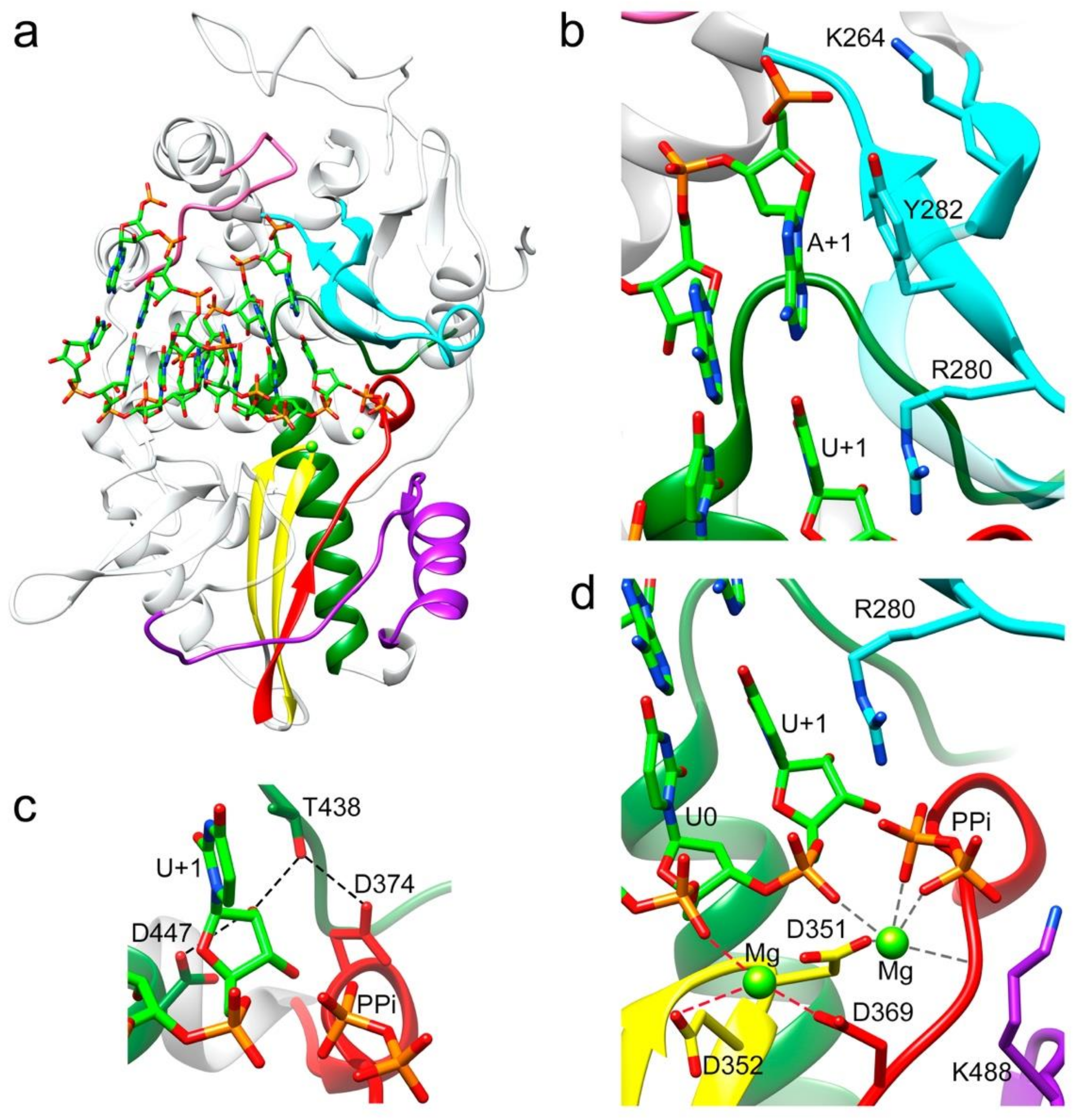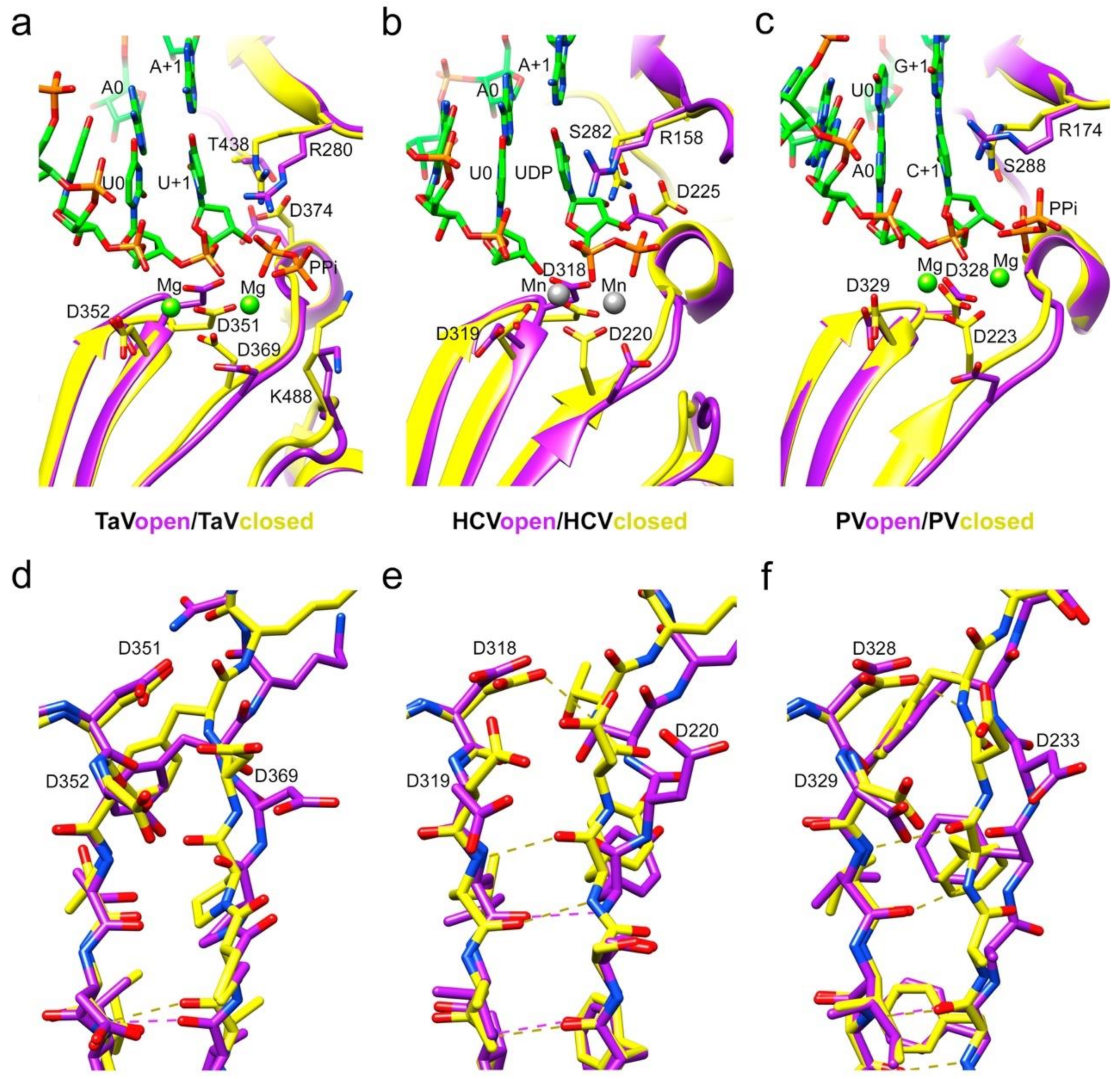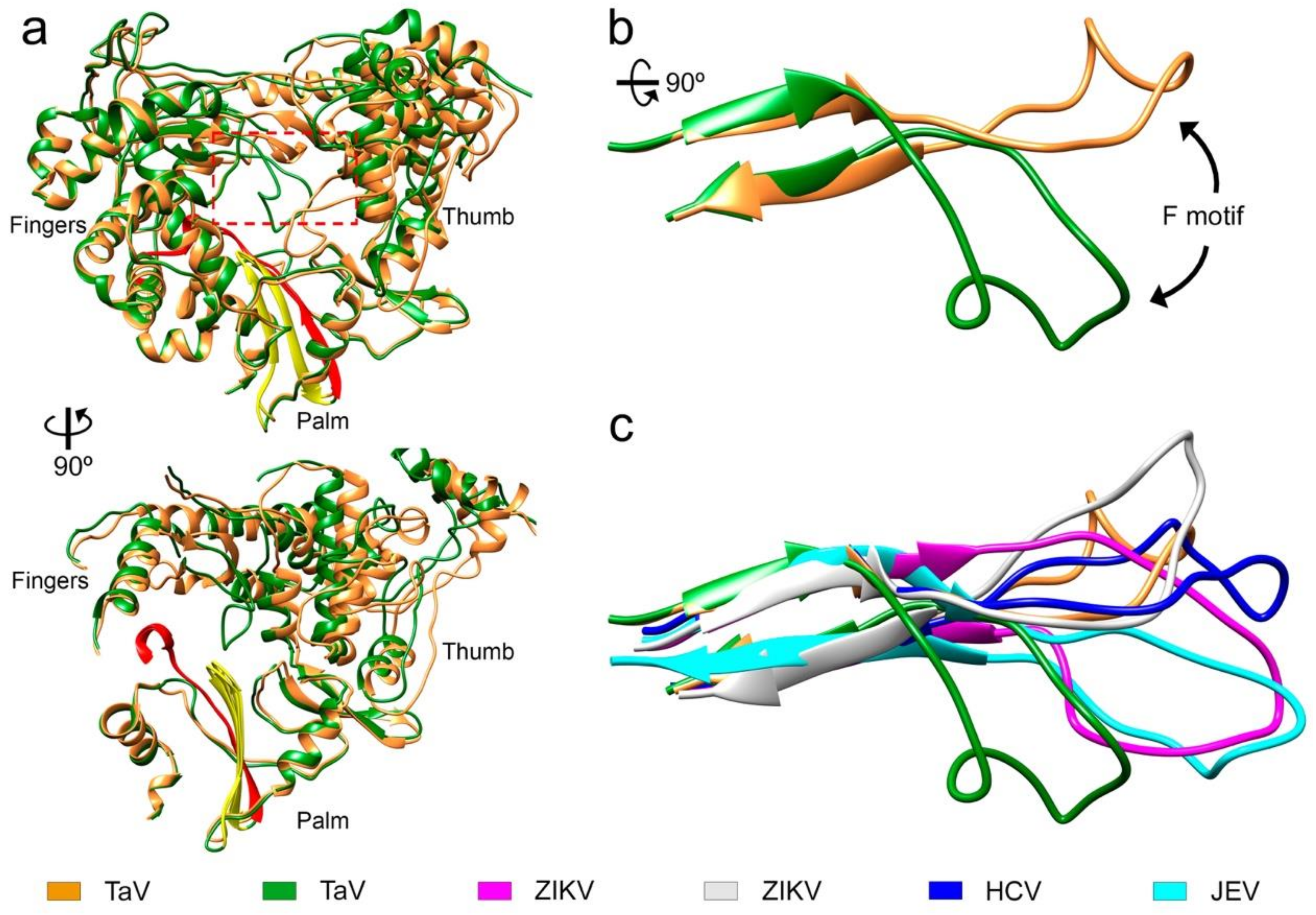Snapshots of a Non-Canonical RdRP in Action
Abstract
:1. Introduction
2. Materials and Methods
2.1. Chemical Synthesis
2.2. DNA Constructs
2.3. Protein Expression and Purification
2.4. Crystallization
2.5. X-Ray Data Collection, Processing, Structure Solution and Refinement
3. Results
3.1. Design of the Crystallizable Catalytic Complexes of TaVpol
3.2. The Structure of Δ10-TaVpolΔ607-624 Bound to a Template-Primer RNA
3.3. The Structure of the Δ10-TaVpolΔ607-624/RNA/rNTP Ternary Complexes
3.4. Non Catalytic Mg2+ in the Central Cavity of TaV RdRP
3.5. Large Movements in the F Motif
4. Discussion
Supplementary Materials
Author Contributions
Funding
Institutional Review Board Statement
Informed Consent Statement
Data Availability Statement
Acknowledgments
Conflicts of Interest
References
- Ferrero, D.; Ferrer-Orta, C.; Verdaguer, N. Viral RNA-Dependent RNA Polymerases: A Structural Overview. Subcell Biochem. 2018, 88, 39–71. [Google Scholar]
- Mönttinen, H.A.M.; Ravantti, J.J.; Poranen, M.M. Structure Unveils Relationships between RNA Virus Polymerases. Viruses 2021, 13, 313. [Google Scholar] [CrossRef] [PubMed]
- te Velthuis, A.J.W. Common and unique features of viral RNA-dependent polymerases. Cell. Mol. Life Sci. 2014, 71, 4403–4420. [Google Scholar] [CrossRef] [Green Version]
- Castro, C.; Smidansky, E.D.; Arnold, J.J.; Maksimchuk, K.R.; Moustafa, I.; Uchida, A.; Gotte, M.; Konigsberg, W.; Cameron, C.E. Nucleic acid polymerases use a general acid for nucleotidyl transfer. Nat. Struct. Mol. Biol. 2009, 16, 212–218. [Google Scholar] [CrossRef] [PubMed] [Green Version]
- Gorbalenya, A.E.; Pringle, F.M.; Zeddam, J.L.; Luke, B.T.; Cameron, C.E.; Kalmakoff, J.; Hanzlik, T.N.; Gordon, K.H.; Ward, V.K. The palm subdomain-based active site is internally permuted in viral RNA-dependent RNA polymerases of an ancient lineage. J. Mol. Biol. 2002, 324, 47–62. [Google Scholar] [CrossRef]
- Zeddam, J.-L.; Gordon, K.; Lauber, C.; Alves, C.A.F.; Luke, B.T.; Hanzlik, T.N.; Ward, V.; Gorbalenya, A. Euprosterna elaeasa virus genome sequence and evolution of the Tetraviridae family: Emergence of bipartite genomes and conservation of the VPg signal with the dsRNA Birnaviridae family. Virology 2010, 397, 145–154. [Google Scholar] [CrossRef] [PubMed] [Green Version]
- Ferrero, D.S.; Buxaderas, M.; Rodríguez, J.F.; Verdaguer, N. The Structure of the RNA Dependent RNA Polymerase of a Permutotetravirus Suggests a Link between Primer-Dependent and Primer-Independent Polymerases. PLoS Pathog. 2015, 11, e1005265. [Google Scholar] [CrossRef] [PubMed] [Green Version]
- Graham, S.C.; Sarin, L.P.; Bahar, M.W.; Myers, R.A.; Stuart, D.I.; Bamford, D.H.; Grimes, J.M. The N-terminus of the RNA polymerase from infectious pancreatic necrosis virus is the determinant of genome attatchment. PLoS Pathog. 2011, 7, e1002085. [Google Scholar] [CrossRef]
- Garriga, D.; Navarro, A.; Querol-Audí, J.; Abaitua, F.; Rodríguez, J.F.; Verdaguer, N. Activation mechanism of a noncanonical RNA-dependent RNA polymerase. Proc. Natl. Acad. Sci. USA 2007, 104, 20540–20545. [Google Scholar] [CrossRef] [Green Version]
- Pan, J.; Vakharia, V.N.; Tao, Y.J. Structural of a birnavirus polymerase reveals a distinct active site topology. Proc. Natl. Acad. Sci. USA 2007, 104, 7385–7390. [Google Scholar] [CrossRef] [Green Version]
- Pringle, F.M.; Gordon, K.H.; Hanzlik, T.N.; Kalmakoff, J.; Scotti, P.D.; Ward, V.K. A novel capsid expression strategy for Thosea asigna virus (Tetraviridae). J. Gen. Virol. 1999, 80, 1855–1863. [Google Scholar] [CrossRef] [Green Version]
- Butcher, S.J.; Grimes, J.M.; Makeyev, E.V.; Bamford, D.H.; Stuart, D.I. A mechanism for initiating RNA-dependent RNA polymerization. Nature 2001, 410, 235–240. [Google Scholar] [CrossRef]
- Surana, P.; Satchidanandam, V.; Nair, D.T. RNA-dependent RNA polymerase of Japanese encephalitis virus binds the initiator nucleotide GTP to form a mechanistically important pre-initiation state. Nucleic Acids Res. 2014, 42, 2758–2773. [Google Scholar] [CrossRef] [PubMed]
- Zhao, B.; Yi, G.; Du, F.; Chuang, Y.C.; Vaughan, R.C.; Sankaran, B.; Kao, C.C.; Li, P. Structure and function of the Zika virus full-length NS5 protein. Nat. Commun. 2017, 8, 14762. [Google Scholar] [CrossRef] [Green Version]
- Rabhi, I.; Guedel, N.; Chouk, I.; Zerria, K.; Barbouche, M.R.; Dellagi, K.; Fathallah, D.M. A Novel Simple and Rapid PCR-Based Site-Directed Mutagenesis Method. Mol. Biotechnol. 2004, 26, 27–34. [Google Scholar] [CrossRef]
- Kabsch, W. XDS. Acta Cryst. 2010, D66, 125–132. [Google Scholar] [CrossRef] [Green Version]
- Evans, P.R.; Murshudov, G.N. How good are my data and what is the resolution? Acta Cryst. 2013, D69, 1204–1214. [Google Scholar] [CrossRef]
- Vagin, A.; Teplyakov, A. MOLREP: An Automated Program for Molecular Replacement. J. Appl. Cryst. 1997, 30, 1022–1025. [Google Scholar] [CrossRef]
- Emsley, P.; Lohkamp, B.; Scott, W.G.; Cowtan, K. Features and Development of Coot. Acta Cryst. 2010, D66, 486–501. [Google Scholar]
- Liebschner, D.; Afonine, P.V.; Baker, M.L.; Bunkóczi, G.; Chen, V.B.; Croll, T.I.; Hintze, B.; Hung, L.W.; Jain, S.; McCoy, A.J.; et al. Macromolecular structure determination using X-rays, neutrons and electrons: Recent developments in Phenix. Acta Cryst. 2019, D75, 861–877. [Google Scholar] [CrossRef] [PubMed] [Green Version]
- Williams, C.J.; Headd, J.J.; Moriarty, N.W.; Prisant, M.G.; Videau, L.L.; Deis, L.N.; Verma, V.; Keedy, D.A.; Hintze, B.J.; Chen, V.B.; et al. MolProbity: More and better reference data for improved all-atom structure validation. Protein Sci. 2018, 27, 293–315. [Google Scholar] [CrossRef] [PubMed]
- Pettersen, E.F.; Goddard, T.D.; Huang, C.C.; Couch, G.S.; Greenblatt, D.M.; Meng, E.C.; Ferrin, T.E. UCSF Chimera--a visualization system for exploratory research and analysis. J. Comput. Chem. 2004, 25, 1605–1612. [Google Scholar] [CrossRef] [Green Version]
- Appleby, T.C.; Perry, J.K.; Murakami, E.; Barauskas, O.; Feng, J.; Cho, A.; Fox, D.; Wetmore, D.R.; McGrath, M.E.; Ray, A.S.; et al. Viral replication. Structural basis for RNA replication by the hepatitis C virus polymerase. Science 2015, 347, 771–775. [Google Scholar] [CrossRef]
- Mosley, R.T.; Edwards, T.E.; Murakami, E.; Lam, A.M.; Grice, R.L.; Du, J.; Sofia, M.J.; Furman, P.A.; Otto, M.J.; Mosley, R.T.; et al. Structure of hepatitis C virus polymerase in complex with primer-template RNA. J. Virol. 2012, 86, 6503–6511. [Google Scholar] [CrossRef] [Green Version]
- Mönttinen, H.A.M.; Ravantti, J.J.; Poranen, M.M. Evidence for a non-catalytic ion-binding site in multiple RNA-dependent RNA polymerases. PLoS ONE 2012, 7, e40581. [Google Scholar] [CrossRef] [PubMed] [Green Version]
- Wu, J.; Gong, P. Visualizing the Nucleotide Addition Cycle of Viral RNA-Dependent RNA Polymerase. Viruses 2018, 10, 24. [Google Scholar] [CrossRef] [PubMed] [Green Version]
- Selisko, B.; Papageorgiou, N.; Ferron, F.; Canard, B. Structural and functional basis of the fidelity of nucleotide selection by flavivirus RNA-dependent RNA polymerases. Viruses 2018, 10, 59. [Google Scholar] [CrossRef] [Green Version]
- Selisko, B.; Potisopon, S.; Agred, R.; Priet, S.; Varlet, I.; Thillier, Y.; Sallamand, C.; Debart, F.; Vasseur, J.-J.; Canard, B. Molecular basis for nucleotide conservation at the ends of the dengue virus genome. PloS Pathog. 2012, 8, e1002912. [Google Scholar] [CrossRef] [PubMed] [Green Version]
- Selisko, B.; Dutartre, H.; Guillemot, J.-C.; Debarnot, C.; Benarroch, D.; Khromykh, A.; Desprès, P.; Egloff, M.-P.; Canard, B. Comparative mechanistic studies of the novo RNA synthesis by flavivirus RNA-dependent RNA polymerases. Virology 2006, 351, 145–158. [Google Scholar] [CrossRef] [Green Version]
- Ferrer-Orta, C.; Arias, A.; Perez-Luque, R.; Escarmís, C.; Domingo, E.; Verdaguer, N. Structure of foot-and-mouth disease virus RNA-dependent RNA polymerase and its complex with a template-primer RNA. J. Biol. Chem. 2004, 279, 47212–47221. [Google Scholar] [CrossRef] [PubMed] [Green Version]
- Ferrer-Orta, C.; Arias, A.; Perez-Luque, R.; Escarmís, C.; Domingo, E.; Verdaguer, N. Sequential structures provide insights into the fidelity of RNA replication. Proc. Natl. Acad. Sci. USA 2007, 104, 9463–9468. [Google Scholar] [CrossRef] [Green Version]
- Ferrer-Orta, C.; Agudo, R.; Domingo, E.; Verdaguer, N. Structural insigthts into replication initiation and elongation processes by the FMDV RNA-dependent RNA polymerase. Curr. Opin. Struct. Biol. 2009, 19, 752–758. [Google Scholar] [CrossRef] [PubMed]
- Ferrer-Orta, C.; de la Higuera, I.; Caridi, F.; Sánchez-Aparicio, M.T.; Moreno, E.; Perales, C.; Singh, K.; Sarafianos, S.G.; Sobrino, F.; Domingo, E.; et al. Multifunctionality of a picornavirus polymerase domain: Nuclear localization signal and nucleotide recognition. J. Virol. 2015, 89, 6848–6859. [Google Scholar] [CrossRef] [Green Version]
- Gong, P.; Peersen, O.B. Structural basis for active site closure by the poliovirus RNA-dependent RNA polymerase. Proc. Natl. Acad. Sci. USA 2010, 107, 22505–22510. [Google Scholar] [CrossRef] [PubMed] [Green Version]
- Gong, P.; Kortus, M.G.; Nix, J.C.; Davis, R.E.; Peersen, O.B. Structures of coxsackievirus, rhinovirus, and poliovirus polymerase elongation complexes solved by engineering RNA mediated crystal contacts. PLoS ONE 2013, 8, e60272. [Google Scholar] [CrossRef] [PubMed] [Green Version]
- Hillen, H.S. Structure and function of SARS-CoV-2 polymerase. Curr. Opin Virol. 2021, 48, 82–90. [Google Scholar] [CrossRef] [PubMed]
- Shu, B.; Gong, P. Structural basis of viral RNA-dependent RNA polymerase catalysis and translocation. Proc. Natl. Acad. Sci. USA 2016, 113, E4005–E4014. [Google Scholar] [CrossRef] [Green Version]
- Wang, M.; Li, R.; Shu, B.; Jing, X.; Ye, H.; Gong, P. Stringent control of the RNA-dependent RNA polymerase translocation revealed by multiple intermediate structures. Nat. Commun. 2020, 11, 2605. [Google Scholar] [CrossRef]
- Jia, H.; Gong, P. A structure-Function Diversity Survey of the RNA-Dependent RNA Polymerases From the Positive Strand RNA viruses. Front. Microbiol. 2019, 10, 1945. [Google Scholar] [CrossRef] [Green Version]





| Δ10-TaVpol Mg2+ | TaVpolΔ607-624 RNA | TaVpolΔ607-624 UMPNPP Mn2+/RNA | TaVpolΔ607-624 UTP Mg2+/RNA | TaVpolΔ607-624 UTP Mg2+/RNA | |
|---|---|---|---|---|---|
| Data Collection | |||||
| Beamline | XALOC | XALOC | P13 | P13 | XALOC |
| Wavelength (Å) | 0.9793 | 0.9789 | 0.9792 | 0.9792 | 0.9793 |
| Resolution range (Å) | 75.5-2.07 (2.14-2.07) | 48.62-2.18 (2.26-2.18) | 56.46-2.4 (2.49-2.40) | 59.01-3.1 (3.21-3.1) | 47.32-3.0 (3.11-3.00) |
| Space group | P21212 | P21 | P21 | P21 | C2 |
| Unit Cell a,b,c (Å) α, β, γ (◦) | |||||
| 134.84, 149.00, 100.37 90.0, 90.0, 90.0 | 65.64, 204.03, 70.08 90.0, 97.2, 90.0 | 67.48, 206.27, 115.59 90.0, 90.7, 90.0 | 67.79, 207.30, 115.98 90.0, 91.1, 90.0 | 215.15, 74.44, 96.56 90.0, 104.65, 90.0 | |
| Total reflections | 648698 (68419) | 332157 (33960) | 1469455 (147126) | 398644 (40225) | 142101 (14520) |
| Unique Reflections | 116569 (12183) | 94404 (9474) | 122324 (12216) | 57906 (5770) | 29693 (2956) |
| Multiplicity | 5.6 (5.6) | 3.5 (3.6) | 12.0 (12.0) | 6.9 (7.0) | 4.8 (4.9) |
| Completeness (%) | 94.4 (99.9) | 99.03 (98.53) | 99.44 (99.58) | 99.89 (99.84) | 98.2 (99.29) |
| <I/ σ(I)> | 9.00 (1.60) | 14.15 (2.53) | 17.25 (1.52) | 6.79 (1.22) | 10.5 (1.5) |
| Rmerge § | 0.1474 (1.342) | 0.071 (0.682) | 0.1305 (1.717) | 0.3841 (2.066) | 0.143 (0.917) |
| Rp.i.m. ◊ | 0.0669 (0.6082) | 0.045 (0.446) | 0.0389 (0.5098) | 0.1578 (0.8418) | 0.109 (0.704) |
| CC1/2 | 0.995 (0.601) | 0.997 (0.737) | 0.998 (0.725) | 0.951 (0.391) | 0.941 (0.514) |
| Refinement | |||||
| Rwork † | 0.1729 (0.2481) | 0.2199 (0.3402) | 0.2145 (0.3443) | 0.2253 (0.3361) | 0.2498 (0.3912) |
| Rfree ‡ | 0.2043 (0.2970) | 0.2346 (0.3305) | 0.2156 (0.3880) | 0.2513 (0.3394) | 0.2663 (0.3841) |
| Protein Residues | 1308 | 1264 | 2518 | 2516 | 1233 |
| R.m.s. deviations | |||||
| Bond length (Å) | 0.008 | 0.012 | 0.010 | 0.006 | 0.004 |
| Bond Angle (◦) | 0.900 | 1.640 | 1.390 | 0.860 | 0.720 |
| Ramachandran Plot | |||||
| Favored (%) | 98.38 | 98.40 | 97.39 | 96.46 | 96.77 |
| Allowed (%) | 1.62 | 1.64 | 2.61 | 3.54 | 3.14 |
| Outliers (%) | 0 | 0 | 0 | 0 | 0.08 |
| PDB ID | 7OM2 | 7OM6 | 7OM7 | 7OMA | 7OM9 |
Publisher’s Note: MDPI stays neutral with regard to jurisdictional claims in published maps and institutional affiliations. |
© 2021 by the authors. Licensee MDPI, Basel, Switzerland. This article is an open access article distributed under the terms and conditions of the Creative Commons Attribution (CC BY) license (https://creativecommons.org/licenses/by/4.0/).
Share and Cite
Ferrero, D.S.; Falqui, M.; Verdaguer, N. Snapshots of a Non-Canonical RdRP in Action. Viruses 2021, 13, 1260. https://doi.org/10.3390/v13071260
Ferrero DS, Falqui M, Verdaguer N. Snapshots of a Non-Canonical RdRP in Action. Viruses. 2021; 13(7):1260. https://doi.org/10.3390/v13071260
Chicago/Turabian StyleFerrero, Diego S., Michela Falqui, and Nuria Verdaguer. 2021. "Snapshots of a Non-Canonical RdRP in Action" Viruses 13, no. 7: 1260. https://doi.org/10.3390/v13071260
APA StyleFerrero, D. S., Falqui, M., & Verdaguer, N. (2021). Snapshots of a Non-Canonical RdRP in Action. Viruses, 13(7), 1260. https://doi.org/10.3390/v13071260








